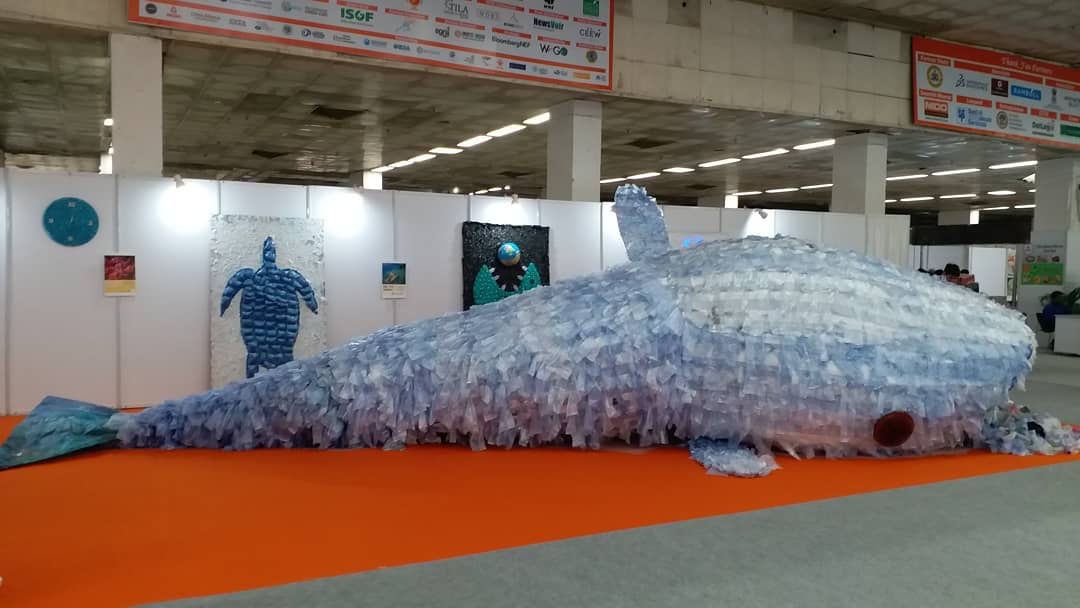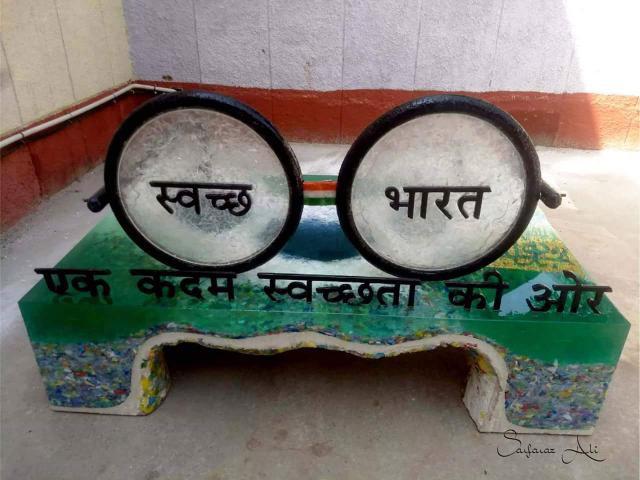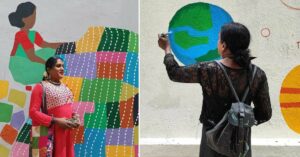Friends Innovate Device to Recycle Plastic; Design Benches Out of Waste for Anganwadis
With their venture SarfarazSakshi Innovation Private Limited, Ghaziabad duo Sakshi and Sarfaraz create sculptures and utility products out of plastic waste, including benches and tables for schools and Anganwadis in UP.

Sarfaraz Ali and Sakshi Jha met while organising an event for the Institute of Management Studies, Ghaziabad, where the latter studied. Over time, the duo collaborated on several events, which they say was their introduction to how much plastic waste is generated at large scale events.
After graduating college in 2011, the two worked in wedding planning until 2017. Even here, Sakshi (31) says, they noticed what a menace plastic waste was.
“We were constantly disturbed by the plastic strewn all around us — spoons, glasses, bottles… Even when we went on road trips, we noticed that most people just throw plastic everywhere, and not where it is to be disposed of, like dustbins,” she tells The Better India.
They would go speak to kabadiwalas (waste collectors) about what happens to plastic waste.

“We learned that segregated plastic waste is taken by recyclers who melt it into a granular form. This is then used to make other products. While this helps in reusing the plastic, the melting process leads to a lot of pollution,” she adds.
Melting plastics is an expensive process that releases several toxins in the air, which not only contribute directly to climate change, but can also lead to respiratory diseases.
For Sakshi and Sarfaraz (35), it was imperative to find a viable solution to this problem. As artists — Sakshi is a Madhubani painter and Sarfaraz practices acrylic art — they decided to do so using their art.
Under their Ghaziabad-based venture SarfarazSakshi Innovation Private Limited — launched in 2018 — they create sculptures and utility products out of plastic waste, including avant-garde pieces made from a combination of acrylics with sand, marble, wood, light, etc. Moreover, they have also designed benches, tables, and more for schools and Anganwadis in UP. With this, they say they have recycled 150 tonnes of plastic so far.
Why two wedding planners turned to art

“My art reflects my life journey, and I have spent days just observing nature,” explains Sarfaraz. “It was while working as an event planner that I realised the true extent of the damage being done to ‘mother nature’. That’s when I decided to think about the planet and create awareness through art.”
In 2018, he designed a machine that can compress plastic without melting it. “The problem with the current way of melting plastic is that when it burns, it produces a lot of smoke, which is bad for the environment. Plastic has a natural quality and strength that enables it to bond on its own with a little bit of heat. Therefore, in my machine, by giving a minimum heat of 60-70 degrees Celsius, the plastic melts without causing harm to the environment,” explains Sarfaraz.
In 2018, the duo designed a 380 kg logo of Swacch Bharat Mission, which is displayed in Nagar Nigam in Ghaziabad. They did this by using 200 kg of polythene waste.
For a while, they worked on several similar projects, all aimed at generating awareness around plastic recycling. Their following works included sculptures like the “world’s largest charkha” in Noida, boards made from plastic waste located across Ghaziabad, and more.
Over time, however, they realised the need to create utility products as well.
As Sakshi explains, “We realised that creating awareness isn’t enough — we also needed to create useful products to demonstrate what we were preaching. We thought of making benches and chairs to serve as a living example of how waste can be turned into productive items. We also started making tree guards, planters, wall clocks, murals, table lamps, etc.”
Process of creating art from waste
The artists currently only work with local and state governments, they say.
To create their work, they first collect plastic waste from local bodies and dump yards in and around Ghaziabad.
Then, their team of six segregates the waste, depending on colour and quality of the plastic. The segregated plastic is then put in a machine that runs at 60-70 degrees Celsius, so as to not melt the plastic. After processing, the plastic is compressed in Sarfaraz’s machine, which converts the waste into a sheet form, which is then used to make the art.
The artists only charge a processing fee to convert the plastic, they say. They collect waste from the municipalities and give it back to them as chairs and tables for Anganwadis as well as benches in schools.
They did a pilot project for an Anganwadi in Bhojpur village in 2021, for which they made 14 furniture items including chairs and tables.
The furniture was made from plastic waste in fun shapes like teddy bears, ducks and horses for the children. They say Uttar Pradesh Chief Minister Yogi Adityanath also appreciated this project and the company is in talks with Anganwadis across the state.
“We have also done a project in a school where we made eco-friendly furniture. These feel just like wooden furniture without having to cut trees, and are cheaper for the government. While a wooden two-seater bench is sold at Rs 6,500, we sell ours at Rs 5,500,” explains Sarfaraz.
Meanwhile, Sarfaraz has also built a machine that can convert PET bottles into ‘cotton’, he says.

“I was inspired by the process of making candy floss, and used the same technique to create a machine that heats plastic, and with the help of rotators, converts it into soft cotton,” he explains.
“Converting PET bottles into cotton for stuffing in jackets, comforters, cushions, and toys is a very lengthy process. There is just one private plant in Kanpur that was set up at a cost of Rs 40 crore. There are no machines made in India for this process. All machines are huge and imported. My machine costs Rs 12 lakh and can convert 400 kg into cotton in a day,” says Sarfaraz.
He hopes to set up more such machines across Uttar Pradesh, and says that each machine can provide employment to 10-12 people.
“Our plan next is to help set up these machines in different places. This would be a game-changer. We are hoping that big PET bottle companies partner with us,” says Sarfaraz.
Meanwhile, Sakshi notes, “Our friends make fun of us, call us kabadiwalas, and chide us for not taking up tenders. We just ignore all this. We only work on a Memorandum of Understanding (MoU) with the government and charge the processing fee — the actual cost it takes us to process and make this art. We will not be swayed from our path of making art from waste by commercialising it.”
Sarfaraz also agrees and says that they ignore the taunts of society.
“Since childhood, I have been interested in art and was good at it. But everyone would make fun of me, as art was considered the domain of girls. I’ve always been interested in helping society and working for the environment. Our work speaks for itself. While my parents weren’t too thrilled about my venture, they were proud when we were praised by the UNDP and signed a project with them,” says Sarfaraz.
They have not patented either of their machines, as they wish for them to be used for the public good.
They also hope that people start disposing of plastic waste properly.

“Sakshi and I will be working for the environment till the day we die. I think that plastic is not wrong, it is we humans who are wrong. We dispose of plastic anywhere and everywhere. We don’t segregate waste. If it is disposed of properly, there are systems in place to recycle it,” says Sarfaraz.
He also urges children to consider solutions to the environmental crisis as a career.
“Everyone wants to be a doctor, engineer, or an IAS officer. Who will take care of the environment then? I hope more children turn into environmentalists,” says Sarfaraz.
Edited by Divya Sethu, Images Courtesy Sarfaraz Ali
If you found our stories insightful, informative, or even just enjoyable, we invite you to consider making a voluntary payment to support the work we do at The Better India. Your contribution helps us continue producing quality content that educates, inspires, and drives positive change.
Choose one of the payment options below for your contribution-
By paying for the stories you value, you directly contribute to sustaining our efforts focused on making a difference in the world. Together, let's ensure that impactful stories continue to be told and shared, enriching lives and communities alike.
Thank you for your support. Here are some frequently asked questions you might find helpful to know why you are contributing?


This story made me
-
97
-
121
-
89
-
167

















